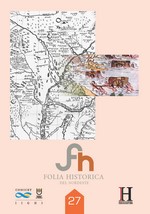Charrúas, Bohanes, Pampas and Guenoa Minuanos in the villages/towns of Missions
DOI:
https://doi.org/10.30972/fhn.0271227Keywords:
Charruas, Guenoa, Minuanos, Bohanes, Missionaries, BordersAbstract
Within the framework of research carried out at the University Development Pole "Centro de investigaciones interdisciplinarias sobre la presencia indígena misionera en el territorio: patrimonio, región y frontera culturales" (Centro Universitario de Tacuarembó; Universidad de la República), relevant attention is being paid to the presence of charruas, bohanes, pampas and guenoa minuanos in mission towns. The research contributes to emphasize that the expression "missionary guarani" - traditionally used as a synonym for "missionary indigenous" - is inadequate, since it ignores the fact of their presence.
Many of the natives who were predominant in the plains south of the reductions joined the villages of missions by acceptance or by force. In some cases, they remained there for generations, maintaining relevant aspects of their identity. The aim of this contribution is to highlight these circumstances, especially with regard to San Borja and Yapeyú. Moreover, I will emphasize the influence of the complexity previously indicated in the borderlands on which the Oriental Republic of Uruguay was built.
Downloads
Published
Issue
Section
License
Se deberá adjuntar una carta, en la que se declare que "el artículo titulado XXX”, es un trabajo original, que no ha sido ni total ni parcialmente publicado en ningún medio impreso o electrónico, que no ha sido remitido simultáneamente a otra publicación y que no se encuentra actualmente en proceso de evaluación en otra publicación. En el caso que sea aceptado para su publicación, transferimos los derechos de publicación a la revista Folia Histórica del Nordeste, quien asume los derechos para editar, publicar, reproducir, distribuir copias, electrónicas o multimedia e incluir el artículo en índices nacionales e internacionales o bases de datos. Por otra parte, dejamos constancia que las afirmaciones vertidas en el mismo son de exclusiva responsabilidad de las/los autoras/es". La carta deberá estar firmada por al menos uno de los autores.






